Japanese knives are known as the world's finest. From kitchen and chef knives, to specialist fish and paring knives, the quality of the best Japanese knives made using traditional craftsmanship is unsurpassed.
And one city in particular can justifiably lay claim to being Japan's capital of traditional knife making: Sakai. Japanese knives made in Sakai are used by over 80% of Japan’s professional chefs.
They also make great souvenirs.
Sakai's knives are the result of a knife-making tradition stretching back some 600 years.
In this fascinating guest post by expert Eric Chevallier, we reveal the different types of Japanese knife, the best for each use in cooking, where you can buy the best knives, along with the venerable history of this remarkable example of traditional Japanese craftsmanship.
Japanese Knives: 600 Years of Craftsmanship
by Eric Chevallier
Sakai's traditional industries
Sakai is a city with 830,000 citizens, located between the International Airport of Kansai and Osaka city. The city is famous in Japan for Daisen Kofun - the biggest burial tomb in the world, built around the 4th to the 6th century.
The first most important period of Sakai city is the Kofun period (3~6th century), when the Yamato kingdom (an old name for Japan) relocated from the mountains of Nara (Sakai east) to the Sakai seaside. During this period bigger and bigger tombs were built for the emperors.
The erection of these monuments attracted many craftsmen, including blacksmiths. Over the past few centuries, craftsmen were kept busy in Sakai, finally deciding to stay in the area. Sakai naturally became the city of sword making, but not only swords.
One of Japan's richest trading hubs
The perfect geographical position of the city, beside the sea, close to Nara - Japan's first Buddhist capital, to Koya pilgrims and Kyoto, Sakai was one of the richest cities of Japan with a powerful trade. Open to the world by its port, the city has long been in contact with other Asian countries like China, Korea, and then Vietnam.
Sakai was a place for exchange and business, becoming the city where Japanese incense, kombu (seaweed), traditional Wagashi sweets, and the world-famous Japanese tea ceremony were all born.
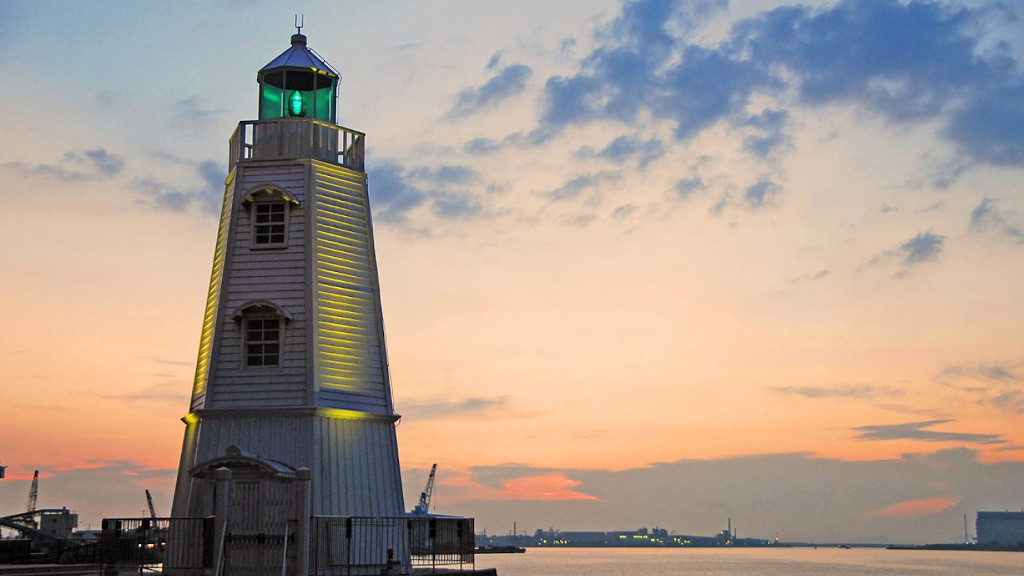
Sakai Port lighthouse overlooking Osaka Bay
From the 12th to the 18th century, the port of Sakai was one of the most important in the country. It enabled many exchanges with foreign countries, and when the first Europeans came to Japan, Sakai entered another significant period.
The birth of Japanese knives
Europeans brought with them guns and tobacco knives to sell. Since the Emperor tomb period, many skilled local blacksmiths living in Sakai decided to copy these tools. Eventually making products of a higher craftsmanship than the European imports.
During the Edo period, in 1570 the Tokugawa Shogun gave his official seal of approval to Sakai's craftsmen, making their knives uniquely authorized, and famous, throughout Japan.
And so, Japanese knives were born.
Sakai was the first city to make kitchen knives, and still continues to be the city of traditional Japanese knives. Today, it produces 80% of all knives commercially available in Japan. Other Japanese cities make blades for foreign markets, but Sakai knives are still handmade, specifically for use in Japanese cuisine.
VIDEO: Sakai Knives - 600 Years of Japanese Craftsmanship, Sakai Hamono Museum
What are the main types of Japanese chef knives?
Japan has approximately 150∼200 different types of knives, because in each region craftsmen adapt blades to suit local culinary culture. But with Western influence, many of these older style blades are not used anymore and the number in use overall has decreased substantially.
Despite this decline, Japan still has a large variety of knives. What follows is a non-exhaustive list of the blades still used most often by Japanese chefs.
All purpose knives
Petty
The word “petty” came from the French word “petit” meaning “small”, because of the 12cm∼16cm blade size.
Petty knives are used as a utility knife for peeling and slicing fruit and vegetables, and chopping and cutting small pieces of meat and fish. This knife is not traditional, but for many years now almost all Japanese chefs use a petty knife.
Santoku
In Japanese, san=three and toku=purpose.
This knife is used for meat, fish and vegetables (including fruit). It is the most versatile knife you'll find in all houses in Japan. This blade is also not traditional and came with the importation of Western cooking styles.
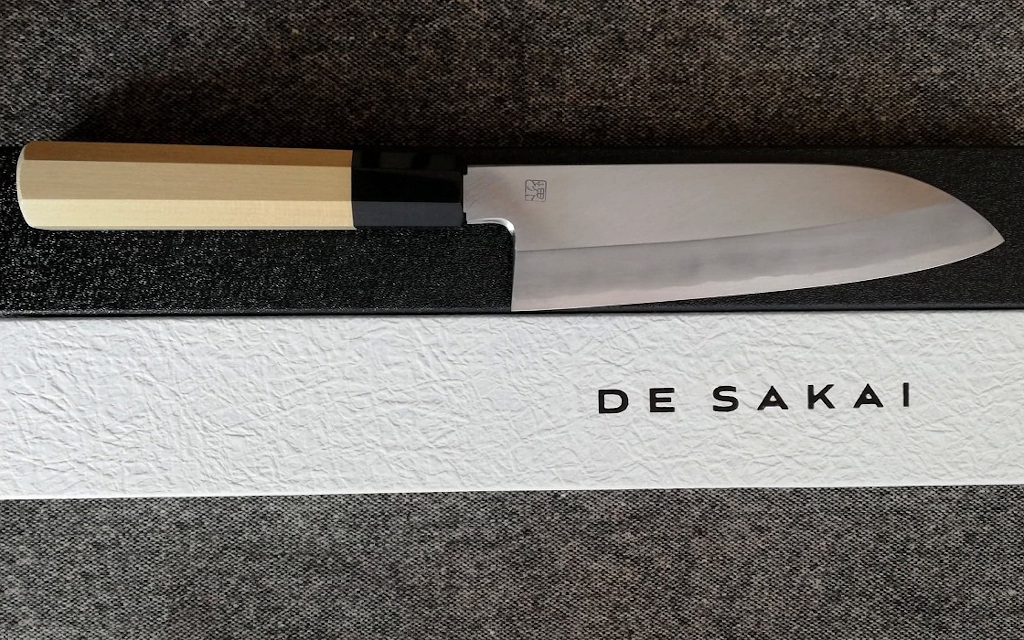
The multi-purpose santoku knife is one you'll find in all Japanese kitchens
Gyuto
You all know the famous tasty Japanese beef, literally Wagyu, so you can understand what a Gyuto is. In Japanese it literally means “beef + sword”, so this knife is a big blade, usually between 21-27cm, but can be bigger in special orders.

The handmade double edge knives are called Sanmai. That means 'three layers' because the base material is hard steel sandwiched between two layers of soft steel.
The handmade single edge knives are called Nimai. Meaning 'two layers' because the base material is hard steel on one layer of soft steel.
The single edge knives cutting performance is better than the double edge, and they are easier to sharpen. These knives have a ridge line at the thickest point of the blade called the ‘shinogi’. Using the shinogi as a guide, it’s easy to find the best angle for sharpening.
If you wonder why Japanese use single edge blades, the answer is traditional Japanese food is mainly raw, and because of the good shape of single edge, the surface of food is smoother and so is less likely to attract bacteria. The single edge was a solution to prevent bacteria appearing on the food.
Kiritsuke: the all-purpose knife
Actually many brands sell double edge kiritsuke style knives that are just a Santoku or a Gyuto with a kiritsuke shape.
It's like a fashion knife people like because of its strong design. It's not wrong because in Japanese “kiri tsuke” means “cut form” as the knife tip/head design has a diagonal cut.

Kiritsuke: the all-purpose knife
But the real Kiritsuke is a big, single edge blade around 24~27cm, used as an all purpose knife many years ago. The authentic Kiritsuke is a good example of a knife that will likely disappear because of the influence of Western and large manufacturers.
Japanese fish knives
Ajikiri: used by fisherman and sushi chefs
Aji is the name of the crevalle jack fish in Japanese, and “kiri” means “cut”. So the Ajikiri is simply a knife used to cut crevalle jack fish and other small kinds of fish. It is mostly used by fishermen and sushi chefs.
Deba: the fish head knife (aka the 'buckteeth blade')
The meaning of 'deba' is interesting because it refers not to the use but to the first blacksmith who made it.
Deba means 'buck teeth' in Japanese. The Japanese kanji for teeth (歯) and blade (刃) are very different, however the pronunciation is the same “ha/ba”. So, because the maker had buck teeth, the Japanese gave his knife the name Deba: the buckteeth blade!
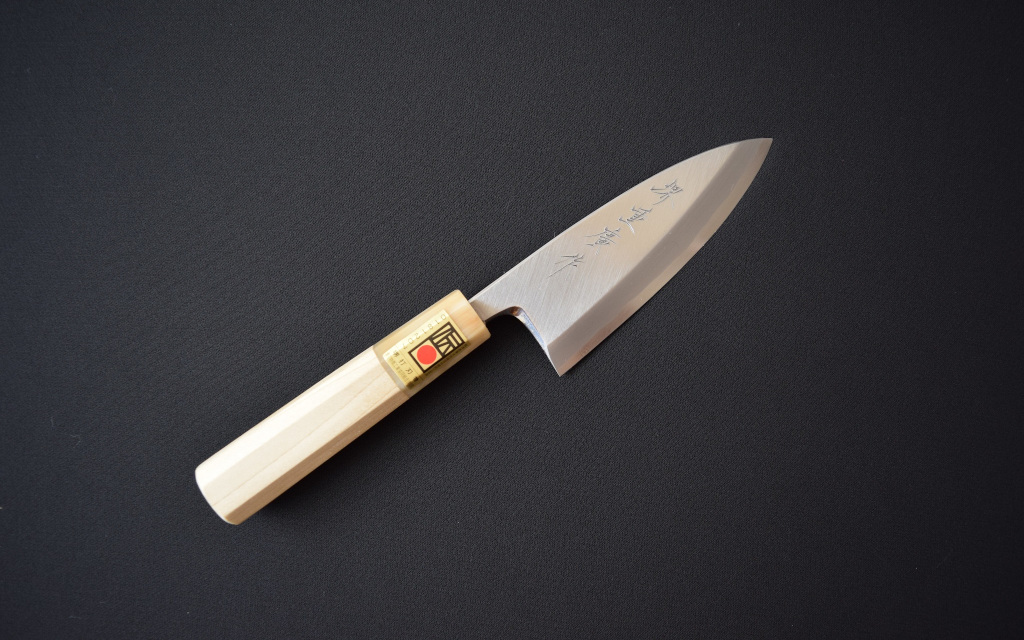
Deba: the fish head knife (aka the 'buckteeth blade')
This knife is a single edge, thick blade used to slice and cut fish heads. The size can be 15cm to 18~21cm at home and in fish restaurants, but we can see bigger and heavier blades up to 30cm length in use in fish markets.
Yanagiba: the 'willow tree' knife
Another interesting name construction, because “yanagi” means “willow tree” in Japanese.
We previously saw that “ha/ba” means “teeth or blade” but it also means 'leaf'. The kanji to write it is different, but the pronunciation is the same.
The yanagiba refers to the shape of the willow tree leaf.
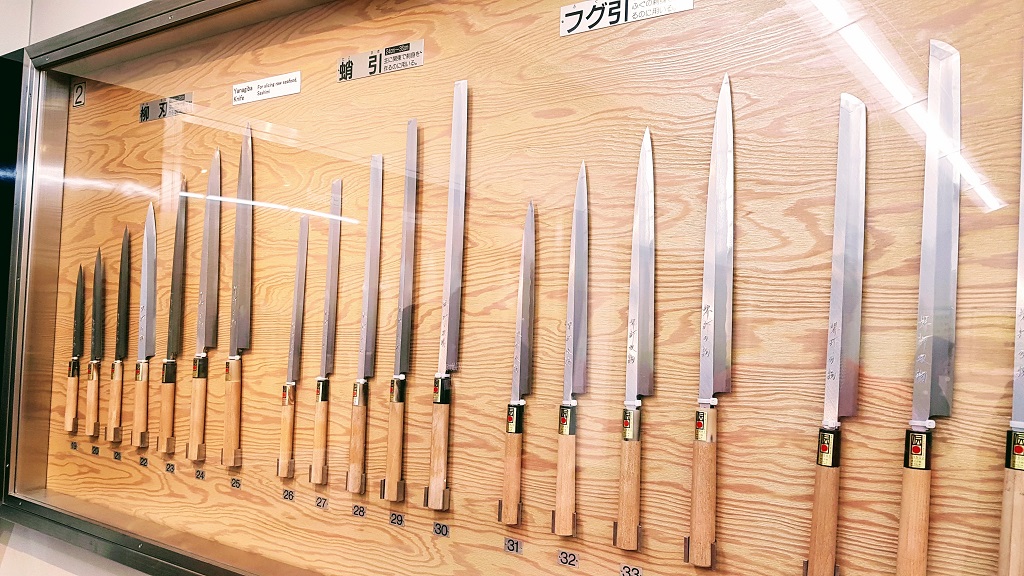
Yanagiba: variations of the 'willow tree' knife on display at Sakai Traditional Crafts Museum
Fuguhiki: the puffer fish chefs' knife
Fugu= puffer fish and hiki= slicing.
This knife is only used for puffer fish by chefs who, because of its poisonous nature, must obtain special authorization to prepare and cook it. Each chef has four or five different fuguhiki knives with different thickness because each fish is different and needs a precise cut.
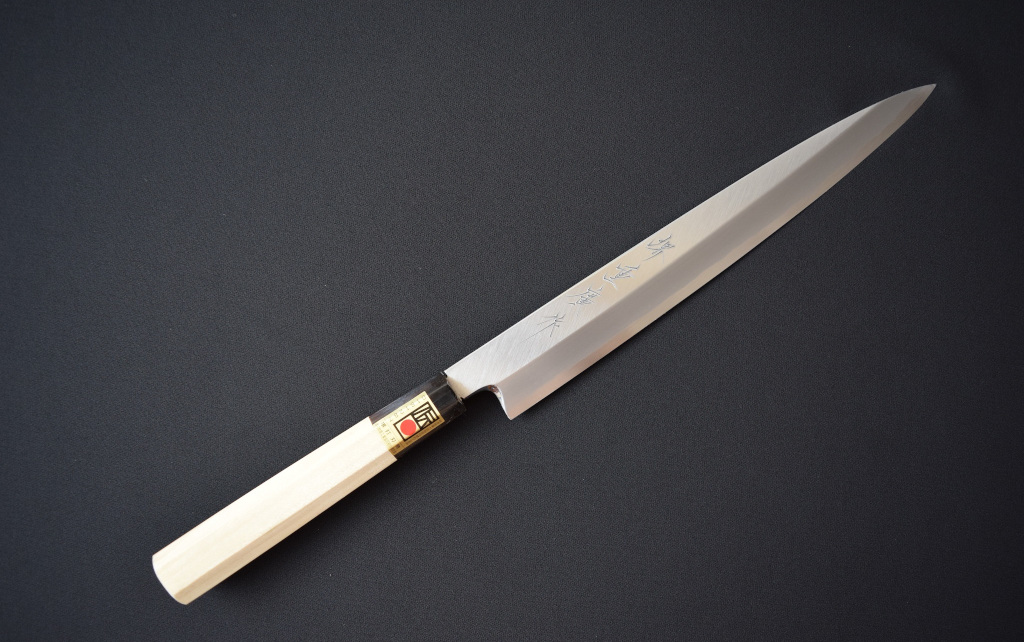
Fuguhiki: the puffer fish chefs' knife
This knife is a single edge blade used for slicing fish. It is the most important knife for sushi chefs to cut thin slices of raw food.
Japanese vegetable knives
Nakiri: inspired by Portuguese tobacco leaf knives
Nakiri means “cut leaf” and is now used mainly to cut cabbage. It was the first double edge Japanese knife, with the single edge version of the Nakiri being the most traditional one. Historically, Japanese knives were born in Sakai city when the Portuguese brought with them tobacco leaf knives.
The Nakiri shape and use is directly inspired from those knives, and we continue making it with a black finishing style called “kurouchi” - resembling the old tobacco knives.
At this point we can say Japanese knives are finally born as a direct result of contact with Westerners. But maybe we can also say that Japanese knives are finally being exported for use back in the West.
Usuba: used to peel and cut vegetables
Usuba means “thin blade”, because this single edge knife is almost as thin as the yanagiba.
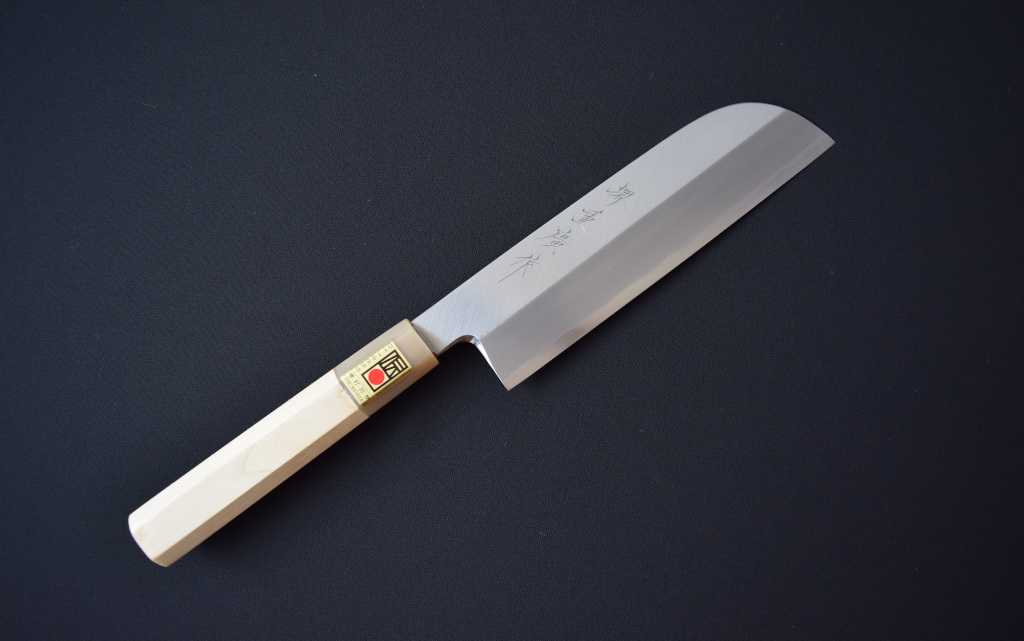
The tip of the usuba knife is either curved or rectangular
The Usuba is the knife most often used to peel and cut vegetables. In the past, usuba and nakiri were the same knife, because Nakiri was a single edge. But when makers started making double edged vegetable knives, the Japanese also started to copy both approaches.
We find two different Usuba knives in Japan. The Kama Usuba is round shaped, the Kansai (Osaka) area style and the Kaku Usuba, rectangular for the Kanto (Tokyo) area.
Kawamuki: the 'skin peeler'
Kawamuki means “skin peeler”, and it’s the ancestor of the petty knife. At first, the kawamuki was a single edge, like a small Kama Usuba. In modern times the kawamuki became a double edge knife. But now it has largely disappeared because people are using Western style petty knives.

A selection of traditional, hand forged Japanese knives
Unagi: Japan's eel knife
Unagi is eel in Japanese and it may be the most representative knife to understand the importance of various shape knives in Japan.
Whereas many shapes disappear slowly, the eel knives continue to be used in different shapes. You can find Kyushu style, Kyoto style, Edo (Tokyo) style, Osaka style and Nagoya style knives.
Eel is one of the most important meals in Japan, and in each area the cutting and preparation style are different. So each eel chef uses a different knife depending on the cutting style required.

What are the differences between knife and samurai sword blades?
Even big brands use the marketing image of samurai swords to sell knives, even though they are nothing like cooking knives!
Of course, blacksmiths use similar tools and materials, like a hammer, anvil, soft steel and hard steel etc., but the final product is totally different. A sword maker doesn't make a good cooking blade, and a knife maker can’t make a good sword because they are two different worlds, with different goals and motivations.
But because people like fancy stories, we increasingly find sellers who don’t know the knife or sword traditions, but link them for a spectacular effect, albeit misleading consumers in the process.
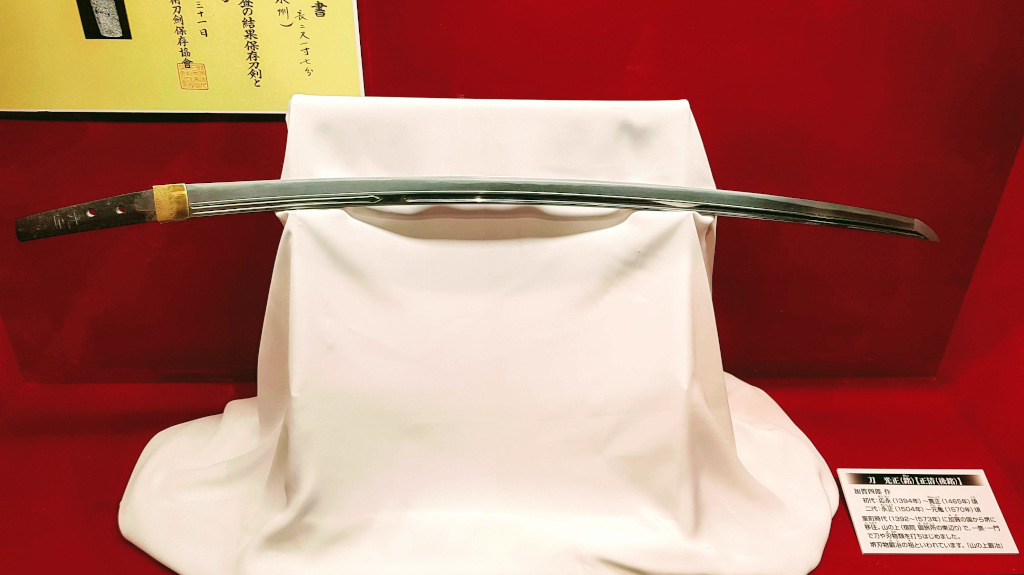
A samurai sword blade on display at the Sakai Traditional Crafts Museum
Having said that, it's true that the tradition of Japanese knife making came from sword making.
Because the great weapons blacksmiths established in Sakai used their sword making knowledge to make the first Japanese knives. But as each Japanese craftsman has his own specialty, it is considered that a great maker cannot engage in diverse activities to be a real professional.
Is it cheaper to buy Japanese made knives in Japan or overseas?
Of course, the best way to get a Japanese knife is to buy it in Japan. Not only will it be cheaper but the quality is guaranteed. It’s difficult to buy a real traditional Japanese knife overseas, because the only pure traditional makers are from Sakai and they almost all sell their entire production in Japan only.
By traditional handmade knife I mean carbon steel knives fully made in Sakai. Even though the Sakai brand sells stainless knives overseas, they're definitely not considered to be traditional knives.
Famous and historic Japanese knife companies
There are many famous Japanese knife companies, but I prefer to focus on historical companies because they continue to protect the tradition of real Japanese knives.
The first place to mention may be the most important, however it is not a brand but a museum.
Sakai Traditional Craft Museum
The Sakai Traditional Craft Museum is the only location in Japan where people can find real traditional Japanese carbon steel knives fully handmade and at maker prices, meaning they are not only cheaper but you're guaranteed of the best quality.
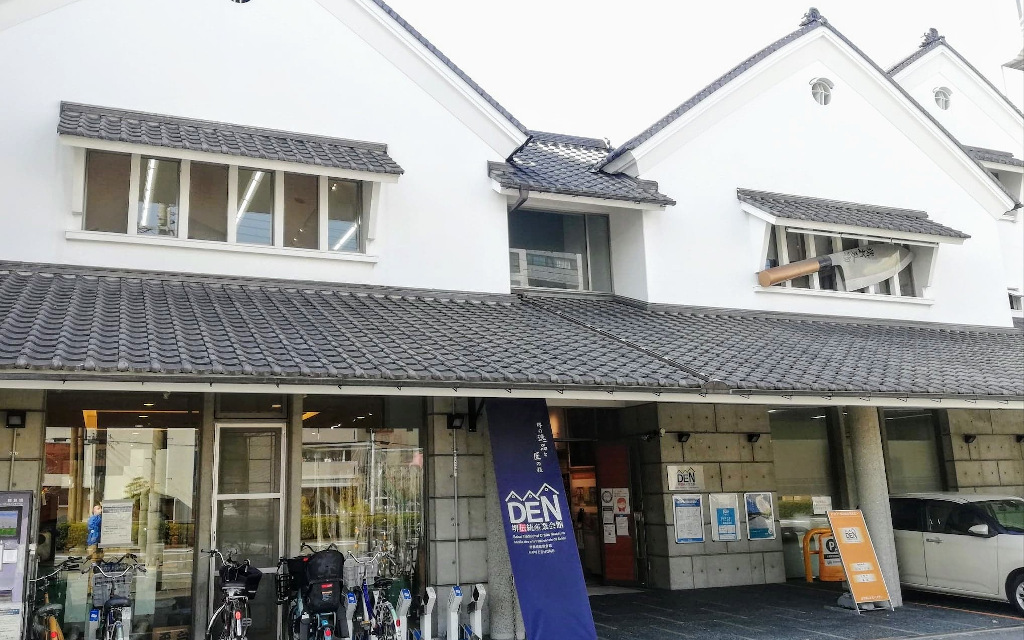
Sakai Traditional Crafts Museum
Established by the Traditional Makers Association in 2006, the building is open to the public, meaning there is no business pressure. Sakai city continues to fund this unique site to preserve and support small craftsmen.
The oldest Japanese brand is Sakai Tohji, which has been in business since 1805. The small company is now a huge brand selling in all of the most famous Japanese department stores. Europe's most famous chefs including Paul Bocuse, Joel Robuchon, Alain Chapel, Ferran Adrià, all use this brand of knife.
The wives of the previous and current Japanese emperors’ also prepare food using this historical brand.
DeSakai brand knives
The second company is the DeSakai brand.
The oldest Japanese forge, a young blacksmith from the Sasuke Blacksmith Works in Sakai, and other certified traditional masters came together to form the brand DeSakai.
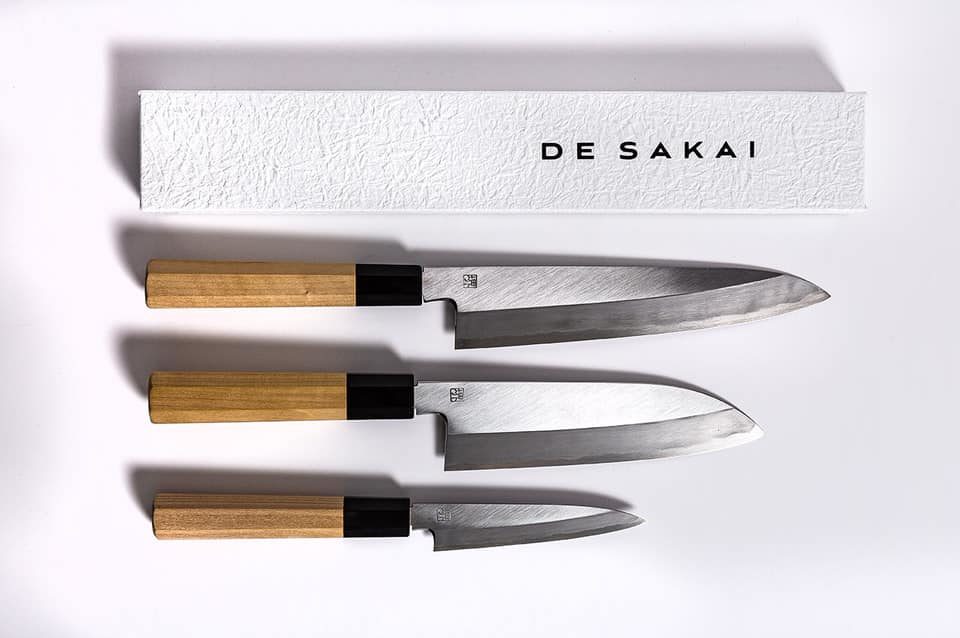
DeSakai brand: knives made by Japan's oldest forge
Their objective was to provide pure traditional handmade Japanese knives that people can’t find overseas, or even easily in Japan.
This brand tries to protect the real soul of this ancient tradition, providing only carbon steel blades with shapes people were readily able to find fifty years ago but rarely can now.
Where can people buy the best Japanese knives?
In Japan you can buy knives everywhere. In all big cities there is a Japanese knife store. The best way to buy it is to go directly to the area.
For a Sanjo area knife, go to Niigata prefecture and visit the wonderful TsubameSanjo Regional Products Store.
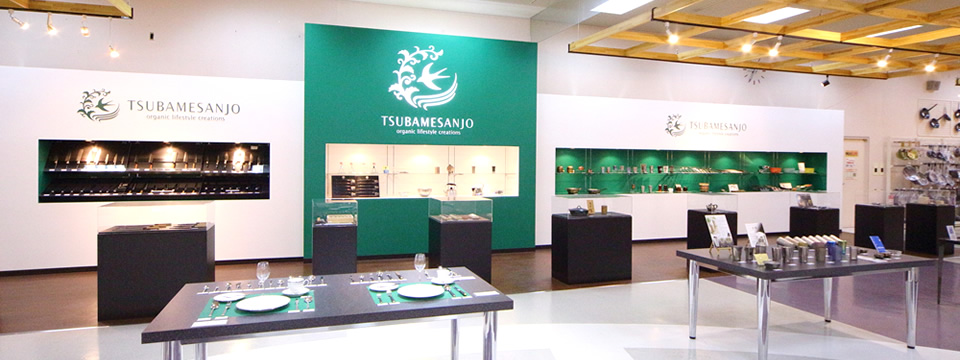
The store showroom at Tsubamesanjo, Niigata Prefecture
For a Takefu area knife, go to Takefu Knife Village.
For a traditional Japanese knife from Sakai, go to Sakai Traditional Crafts Museum.
Buying Japanese knives online
It’s easy to find knives online, especially as interest grows in Japanese makers. However, people should be aware that there is a huge difference between big brands who sell industrial stainless knives and real traditional Japanese knives.
As described above, today only a few brands sell real traditional handmade blades. Presently, the DeSakai brand offers a limited choice because all products are handmade, maintaining traditional craftsmanship.
Some famous brands can easily make between 100 and 500 knives a month, whereas DeSakai only makes approximately 10-20 knives, as they do not offer machine made blades. This is not through any lack of modern manufacturing knowledge, but rather because of their brand spirit.
What should people look for when buying knives?
When buying traditional knives just as important as the blade is the handle.
Traditional knives are made with carbon steel, so the handle should be high quality wood. That means hardwood. You cannot make a mistake if you buy a carbon steel knife with a magnolia wood handle and a buffalo horn bolster. This is the most traditional and highest quality knife.
With their Western influence, many people like their knife handles to be black. If that's what you want, then I recommend ebony wood handle and a buffalo horn bolster. However, this can be a little heavy and brittle if you drop it on the ground because the ebony is a really hard material.
These days, makers prefer to use cassia wood handles that are stronger and cheaper than ebony wood.
Be careful, a traditional carbon knife needs to be looked after.
Never wash it in the dishwasher, always clean it by hand. And be sure to dry it with a soft fabric after you finish cleaning before using it.
If you don’t want a carbon steel knife because you are afraid of rust, you can choose a stainless knife. But then why buy a Japanese knife if the blade is not a traditionally made one. 😉

About the Author
Eric Chevallier came to Japan in 2012 from France, and is the only foreigner to finish a traditional full 5 years apprenticeship as a Japanese blacksmith. He works for the Sakai city promotion office at the Sakai knives museum and manages the craftsmen brand DeSakai with other Sakai knife makers.
Sakai City Location Map
Japanese knife experiences you can reserve
If you're interested in learning more about Japan's tradition of exquisite knife-making check out my post called 5 Exclusive Japanese Knife Experiences With Traditional Artisans for details on how you can actually craft your own Japanese knife souvenir.
Resources
Regional Japanese Knife Stores
Fukui Prefecture:
Takefu Knife Village
Niigata prefecture:
TsubameSanjo Regional Products Store
Osaka Prefecture:
Sakai Traditional Crafts Museum
Online Japanese Knife Stores
DeSakai Brand
https://www.desakai.com
Takefu Knife Association
https://tkvstore.net/
Yauchi Hamono (Japanese only)
https://yauchihamono.thebase.in/
Sanjo Hinoura (Japanese only)
https://www.takumi-hinoura.com/
Masuda Kiriide Factory (Japanese only)
https://masukiri.thebase.in/
Further Related Reading
5 Exclusive Japanese Knife Experiences With Traditional Artisans
5 Finest Japanese Knife & Katana Crafting Experiences in Tokyo


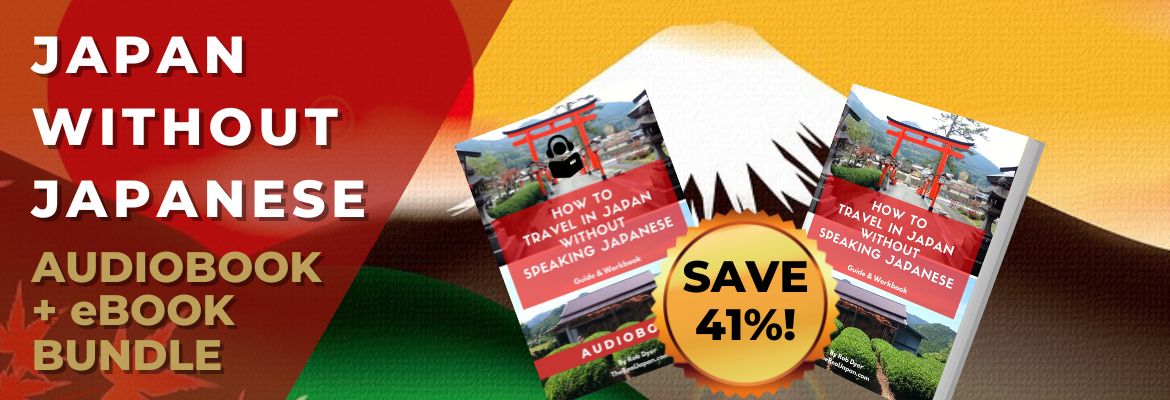
Is it possible to go to Japan & find someone to build a custom knife set, a presentation case, with drawers. Then send it to UK?
Hello Mark – that may be possible – but you’d probably need to get the knives made by one company and the presentation case by another as they’re quite different skillsets.
For the knives, Hirata Swordsmith take orders from overseas: https://mokomimi1027.wixsite.com/my-site-2/
For the presentation case try Mogami Kogei: https://sasimono.ciao.jp/others/request.html – They are the company behind this bookable chopstick making experience: https://otonami.jp/wabunka/experiences/en_mogami-kogei/?ref=therealjapan
Are there any workshops where we might be able to see metal being forged or to get a hands on class for stone sharpening technique? We will be in Osaka area March 2023!
Hi MKat, that’s great news! If you’re a subscriber email me at hello@therealjapan.com and I’ll send you some personal suggestions.
I’ll also post links to some Sakai/Osaka knife/forge experiences here:
Sakai: Highlights Bike Tour: https://www.getyourguide.com/s?partner_id=SW8N3EC&q=Osaka&et=390385&lc=1204
Sakai Private Tour – Find the Very Own Kitchen Knife: https://tidd.ly/3DUSl0K
Tickets for Knife Sharpening Lesson in Sakai: https://www.tiqets.com/en/osaka-attractions-c28/tickets-for-knife-sharpening-lesson-in-osaka-p977785/?partner=therealjapan
Sakai Knife Factory Tour with Sharpening Techniques: https://www.japantouradventure.com/sakaiknifefactory?trackingCode=94e7b6e4ca554ae799682f3c9eef24e1
Brilliant article, thank you Eric.
I’m also lucky to be working with some of the most talented knife craftsmen from Sakai, Osaka and I can sign with both hands that the amount of love and detail that goes to creating each piece is extraordinary.
That’s fantastic Kamila that you’re also working with Sakai knife craftsmen, and so pleased that Eric’s article resonated so much with you.
Hi Eric and Rob,
Awesome guide here. I have always been impressed by Japanese knives. 600 years is a long time; they have perfected cutting. Funny too how I looked up Ginsu knives and it turns out Berkshire Hathaway owned the knife; famed thru infomercials throughout the US and it was about as Japanese as McDonald’s LOL.
Ryan
Thanks Ryan. Eric knows his stuff!
Don’t worry, you wouldn’t be the first (or the last) to be fooled by that kind of branding and marketing tactics. It’s actually very common.
Many knives that have Japanese (or Japanese-appearing) names are made by big knife manufacturers in other countries who are cashing in on the reputation of genuine Japanese knives.
Yes, I do agree with you that Japanese knives are the finest ones all over the world. I really enjoyed reading about Japanese knives. I would love to have one Japanese knife. Thanks for sharing this wonderful post with us!
You’re welcome Ella. You should plan on picking one up when you visit Japan next!
What an amazing and thorough article about Japanese knives and the city of Sakai. I know there is another city in Gifu Prefecture called Seki famous for knives. Do you know which one is older (more famous)?
Hello Lena san,
The history of Seki is few different than Sakai. Both have a long experience in sword making, but Sakai is the older for kitchen knives.
Sakai is more famous for traditional carbon knives used for japanese traditional cuisine whereas Seki is more famous overseas because they make modern style stainless knives.
We consider about 70~80% of professional japanese knives national market are from Sakai.
To make it simple (even its more complicated)
In Japan, Sakai knives are more for professionals of tradition cooking then Seki knives are more for home using or non japanese restaurant.
Overseas big famous stainless knives brand are more from Seki.
But do not forget Takefu and Sanjo knives, well know by foreigners knives collectors and lovers. Both make carbon and stainless knives, with a mix of traditional and modern process.
Sakai= Capital of the tradition, only small forge and old tools (japanese professional traditional market / few foreigners professionals)
Seki=Capital of modern process, many big factories (japanese home using market and foreigner market)
Takefu = regrouping of young and old, dynamic craftsmen in a same factory with modern tools and process. (more foreign market)
Sanjo= A mix between Sakai and Seki, with small traditional forge and also huge factories (well know in Japan for kitchenware ustensils / well know overseas for knives).
It exist others cities but they are not well know (mainly Tosa, Niimi, Miki…).
Best regards
Hey Eric, thanks so much for your detailed answer!
My husband has been wanting to buy knives every time we visit Japan. Are these allowed in the checked in baggage? That’s been our concern.
Hi Ces – thanks for your question.
They have been allowed for my wife and I in the past when flying from Japan to the UK.
I imagine we’ve flown with different airlines and still done this. (We’ve brought knives back from Japan more than once.)
But probably wise to double check with your airline in advance.
Another alternative might be to post any souvenirs back to yourself instead of travelling with them.
I’ve done this a couple of times down the years when it has been something bulky.
Hope this helps!
Hello Ces,
Rob is right, the best way to know is to check with your airline.
Of course put it always in checked luggage not hand baggage.
For a sword, you need a license you can usually get from the seller (need 1~2 week to complete the registration. I recommend to ask to Real Japan and Rob for any service here)
Normally, if its a cooking knife there is no problem, even for a tuna knife that can be bigger than a sword (~60cm).
Certainly to the UK as I’ve brought kitchen knives in from Japan
That’s my experience too Carl. Thanks for adding your experience.